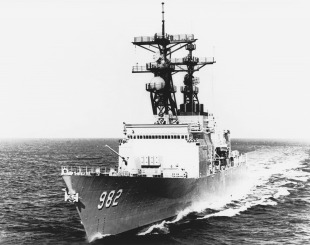Есмінець USS Nicholson (DD-982)
Основна інформація
Головні розміри
Машина
- 4 * General Electric LM2500 gas turbines
- 2 * shafts, 80,000 shp (60 MW)
Персонал
Бойові сили та засоби
- AN/SPS-40 air search radar
- AN/SPG-60 fire control radar
- AN/SPS-55 surface search radar
- AN/SPQ-9 gun fire control radar
- Mark 23 TAS automatic detection and tracking radar
- AN/SPS-65 Missile fire control radar
- AN/SQS-53 bow mounted Active sonar
- AN/SQR-19 TACTAS towed array Passive sonar
- Naval Tactical Data System
- AN/SLQ-32 Electronic Warfare System
- AN/SLQ-25 Nixie Torpedo Countermeasures
- Mark 36 SRBOC Decoy Launching System
- AN/SLQ-49 Inflatable Decoys
- 2 * 5 in (127 mm) 54 calibre Mark 45 dual purpose guns
- 2 * 20 mm Phalanx CIWS Mark 15 guns
- 1 * 8 cell ASROC launcher (removed)
- 1 * 8 cell NATO Sea Sparrow Mark 29 missile launcher
- 2 * quadruple Harpoon missile canisters
- 2 * Mark 32 triple 12.75 in (324 mm) torpedo tubes (Mk 46 torpedoes)
- 1 * 61 cell Mk 41 VLS launcher for Tomahawk missiles
- 1 * 21 cell RIM-116 Rolling Airframe Missile launcher
- 2 * Sikorsky SH-60 Seahawk LAMPS III helicopters
The USS Nicholson (DD-982), a destroyer from the Spruance-class, was the fourth vessel of the US Navy named after a family that played a significant role in early American naval history. This family included James Nicholson, the senior Captain in the Continental Navy, and Samuel Nicholson, the initial captain of the USS Constitution.
Nicholson's construction commenced on February 20, 1976, at Ingalls Shipbuilding in Pascagoula, Mississippi. She was launched on November 11, 1977, and entered service on May 12, 1979. The ship's maiden deployment took place on November 18, 1980.
In 1983, Nicholson sailed to the Persian Gulf and returned to Charleston SC via the Suez Canal, with a refueling stop in Djibouti. While journeying across the Atlantic, the ship encountered rough seas, resulting in damage to the sonar dome. This was repaired during a scheduled maintenance period at the Brooklyn Navy Shipyard between May 1984 and February 1985.
Post maintenance, Nicholson returned to Charleston, SC, undergoing various training exercises for the subsequent deployment, including Combat Systems Ship Qualification Trials, Anti-Submarine Warfare exercises in the Caribbean, and Refresher Training in Guantanamo Bay, Cuba.
In February 1990, Nicholson was deployed for six months to the Persian Gulf as part of the Mid-East Force, encountering notable incidents involving armed Iranian F-4s overflying the ship and leaving the Persian Gulf a week before Iraq invaded Kuwait.
In January 1992, Nicholson joined NATO's Standing Naval Force Atlantic, visiting multiple ports before serving as the flagship under a US Admiral, RADM Dwyer.
During an early 1994 deployment with USS Saratoga, Nicholson supported various operations in the Persian Gulf, Mediterranean Sea, and the Adriatic Sea.
As part of a reorganization in July 1995, Nicholson was reassigned to Destroyer Squadron 18 within the U.S. Atlantic Fleet.
Following an overhaul in September 1995, Nicholson shifted its homeport to Norfolk Naval Shipyard in Portsmouth, Virginia, due to the closure of Charleston Naval Shipyard.
Nicholson embarked on several deployments, participating in exercises and operations, including a Sink Exercise (SINKEX) in August 1998, the Operation Southern Watch in the Persian Gulf, and Operation Allied Force in Yugoslavia.
During its service, Nicholson was involved in minor incidents like a collision with USS Detroit in 2000 and conducted numerous deployments, finally being decommissioned on December 20, 2002, and sunk as a target on July 30, 2004.
The official emblem of Nicholson commemorates five distinguished American naval officers from the Nicholson family who served during crucial periods in American history. The crest's elements symbolize combat achievements, naval strength, and the ship's mission, encapsulated by the Latin motto «FORTES FORTUNA ADIUVAT,» meaning «Fortune Favors the Brave.»
- Коментарі
 uk
uk en
en ru
ru



 Військово-Морські Сили США
Військово-Морські Сили США Ingalls Shipbuilding
Ingalls Shipbuilding